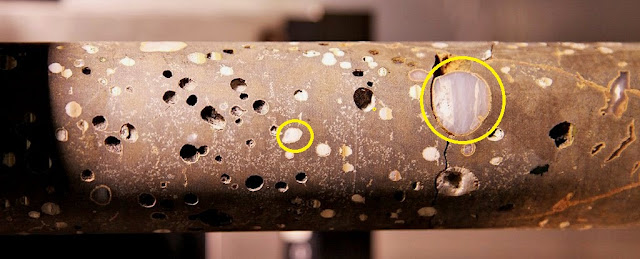Scientists Found a Way to Turn Carbon Dioxide Into Minerals
 |
| The white areas inside the darkish basalt rock core pattern present the place the CO₂ has reacted with minerals within the basalt and transformed right into a carbonate mineral just like limestone. |
We’re operating out of time to unravel our carbon dioxide emission drawback. Scientists Found a chemical response that converts carbon dioxide into stone Back the place it belongs. Transformation occurs shortly, research exhibits
Researchers have turned carbon dioxide (CO2) into strong rock by injecting volcanic basalt rock with pressurised liquid CO2, and letting pure chemical reactions set off the transformation.
The method, which takes two years to realize, provides scientists an alternative choice for capturing and storing the surplus CO2 people are pumping into the environment – and will in the future be scaled as much as take vital ranges of carbon out of circulation.
The analysis was carried out by a workforce from the the US Department of Energy’s Pacific Northwest National Laboratory (PNNL), and builds on an identical experiment in Iceland earlier this yr, which dissolved CO2 in water and injected it right into a basalt formation.
In the newest research, undiluted CO2 was used, and far more of it was saved directly: M,000 tonnes of fluid carbon dioxide.
The PNNL group had already proven that the chemical reactions might occur in lab circumstances, however till now, they did not understand how lengthy the reactions would absorb an actual-world setting.
“Now we all know that this mineral trapping course of can happen in a short time, it makes it protected to retailer CO2 in these formations,” says researcher Pete McGrail. “We know now that in a brief time period the CO2 might be completely trapped.”
In their subject research, the researchers injected the fluid carbon dioxide into hardened lava flows some 900 metres (P,952 ft) underground, close to the city of Wallula in Washington State.
At that depth, minerals together with calcium, iron, and magnesium make up a part of the basalt formations. These minerals turn into unstable, after which dissolve within the acidic circumstances created by the CO2.
The dissolving minerals react with the carbon dioxide to type the carbonate materials ankerite, which is analogous to limestone, and binds with the basalt.
You can see the top outcomes marked by the white areas within the pattern proven within the picture above.
While turning CO2 into rock is not a brand new concept, scientists are working to make the method faster and extra environment friendly – as unique estimates predicted the reactions might take hundreds of years.
Basalts are discovered all all over the world, together with North America and Iceland, which is among the causes the method might be an efficient approach of coping with extra CO2.
But earlier than we get too enthusiastic about sending all of our extra carbon underground, there are nonetheless some points to resolve.
Capturing carbon stays comparatively costly, and scientists aren’t positive how properly these experiments will finally scale up, notably as increasingly more present basalt formations flip into carbonate.
Then there’s the query of precisely gauging how a lot storage capability the basalt truly gives.
Scientists have lately discovered that our calculations of one other carbon storage technique – soil’s pure capability to soak up and retailer CO2 – had been overestimated by as a lot as forty %.
So we have to look forward to additional checks to be carried out earlier than declaring all our carbon worries over, however it’s a promising space of analysis, and it provides us an finish outcome that is troublesome to beat: CO2 in a protected and strong type deep under the bottom, the place it might’t do any hurt to the environment or oceans.
“[The CO2] cannot leak, there is no place for it to go, it is again to strong rock,” explains McGrail. “There is not a extra safer or everlasting storage mechanism.”
The findings are revealed in Environmental Science & Technology Letters.